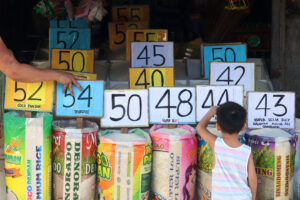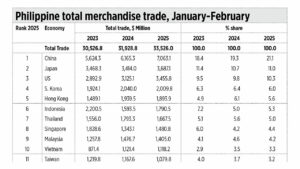March inflation slows to near 5-year low

By Aubrey Rose A. Inosante, Reporter
Inflation eased to its lowest annual rate in nearly five years in March, as food and transport costs rose at a slower pace.
Preliminary data from the Philippine Statistics Authority (PSA) showed the consumer price index rose to 1.8% in March, easing from the 2.1% in February and 3.7% a year ago.
It was within the 1.7%-2.5% forecast from the Bangko Sentral ng Pilipinas (BSP), but slightly below the 2% median estimate in a BusinessWorld poll of 18 analysts last week.
The March print was the lowest in 58 months or since the 1.6% logged in May 2020 at the height of the coronavirus pandemic.
For the first quarter, inflation averaged 2.2%, well within the central bank’s 2-4% target.
National Economic and Development Authority (NEDA) Secretary Arsenio M. Balisacan said the continued decline in inflation shows the effectiveness of government efforts to stabilize prices.
“While the inflation rate continues to ease and remain within the target range, we commit to monitoring risks and shocks, particularly on anticipated electricity rate hikes and higher prices of fish and meat, and addressing them through timely and targeted interventions,” he said.
Core inflation, which excludes volatile prices of food and fuel, eased to 2.2% in March from 2.4% in the previous month and 3.4% a year prior.
“The main reason for the lower inflation rate in March 2025 compared to February 2025 is the slower increase in the prices of food and non-alcoholic beverages, which rose by 2.2%,” National Statistician Claire Dennis S. Mapa said in mixed English and Filipino on Friday.
The food and non-alcoholic beverages index rose to 2.2% in March, slowing from 2.6% in February and 5.6% in the same month in 2024.
Food inflation further eased to 2.3% in March from 2.6% a month ago and 5.7% the year prior.
This was mainly due to cereals and cereal products, which declined to 5.2% in March from the 3% drop in February and a reversal of the 17.3% increase in the same month last year.
Rice inflation further contracted to 7.7% in March from the 4.9% decline in February. This was the lowest rice inflation since the 8.4% contraction in March 2020, Mr. Mapa said.
“Rice prices have significantly decreased, as you may remember that when the tariff reduction started, the drop in rice prices was quite slow. But this March, there has been a substantial decrease — overall rice reduction is -7.7%,” Mr. Mapa said.
Executive Order 62, which took effect in July 2024, slashed tariffs on rice imports to 15% from 35% until 2028 to curb inflation.
The Department of Agriculture (DA) in February declared a food security emergency on rice, which authorized the National Food Authority to release buffer stocks at subsidized prices.
The DA also further lowered the maximum suggested retail price (MSRP) of 5% broken imported rice to P49 per kilo from P52 per kilo, starting March 1.
According to Mr. Mapa, the average price of regular milled rice nationwide fell by 9.8% to P46.09 in March compared to P51.11 in the same month last year.
The average price of well-milled rice slipped by 7.4% to P52.25 from P56.44 in March 2024.
Meanwhile, the price of special rice fell to P60.15 per kilo from P64.75 in the same month a year earlier.
Mr. Mapa noted the annual price growth of meat and other parts of slaughtered land animals, particularly pork meat. It eased to 8.2% in March from 8.8% in the previous month.
At the same time, transport inflation was also a source of slower inflation in March, as it contracted to 1.1% from the 0.2% drop in February.
Gasoline prices declined at a faster pace to 7.5% in March from the 4.7% drop in the month prior. Diesel costs also dropped at a quicker pace to 5% in March, from the 3.4% dip in February.
In March, pump price adjustments stood at a net decrease of P1.50 a liter for gasoline, P1.10 a liter for diesel and P2.40 a liter for kerosene.
“Also contributing to the decrease in transport inflation is the slower increase in the prices of other passenger transport by road, which had an inflation rate of 0.2%. This specifically includes tricycle fares,” Mr. Mapa said.
Mr. Mapa also noted the slower annual growth in the restaurants and accommodation services index to 2.3% in March from 2.8% a month ago.
Meanwhile, the PSA cited meat of pigs with 2.8% inflation rate as main contributor to the March inflation. This was followed by restaurants, cafe and the like, meat of poultry (10.8%), rentals (1.6%) and other pelagic fish (2.4%).
“In our food basket, meat prices are high, followed by fish. Vegetables have slightly decreased but remain relatively high. The high meat prices are primarily due to pork, which has been triggered by supply issues related to ASF (African Swine Fever),” Mr. Mapa said.
Meanwhile, inflation for the bottom 30% of income households further decelerated to 1.1% in March from 1.5% in February and 4.6% a year ago.
Consumer prices in the National Capital Region (NCR) eased to 2.1% in March from 2.3% in February. Outside NCR, inflation slowed to 1.8% from 2%.
Rizal Commercial Banking Corp. Chief Economist Michael L. Ricafort attributed the slower inflation in March to better weather conditions that slowed down the increase in food and vegetable prices, particularly rice.
He noted world rice prices are at the lowest in over three years or since November 2021.
Mr. Ricafort also cited the stronger peso versus the US dollar that reduced import prices and overall inflation, as well as lower global crude oil prices.
Analysts said the March inflation print gives the central bank room to cut interest rates at next week’s meeting.
“More benign inflation at 1.8% in March 2025 or already slightly below the lower end of the 2%-4% BSP inflation target would support monetary easing particularly possible -0.25 BSP rate cut as early as the April 10 BSP rate-setting meeting,” Mr. Ricafort said in a Viber message.
The BSP unexpectedly kept rates steady at its February policy review, opting to keep the benchmark at 5.75%. This after it delivered three straight 25-bp cuts at each of its meetings in August, October and December.
“Target consistent inflation and slowing growth momentum should be enough to convince the Bangko Sentral ng Pilipinas to cut rates by 25 basis points next week,” Nicholas Antonio T. Mapa, chief economist at Metropolitan Bank & Trust Co., said on social media platform X.
BSP Governor Eli M. Remolona, Jr. earlier said a rate cut is still “on the table” at the Monetary Board’s meeting this month, signaling “a few more” rate cuts for the rest of the year.




